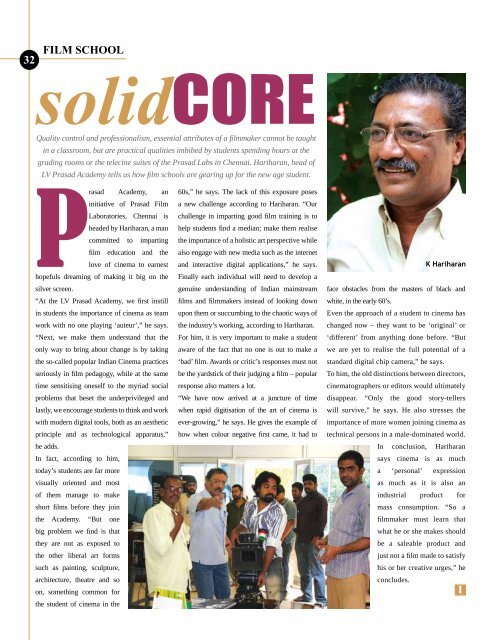READ MORE ABOUT AlsO fEATURED fOCUs ON - Kodak
READ MORE ABOUT AlsO fEATURED fOCUs ON - Kodak
READ MORE ABOUT AlsO fEATURED fOCUs ON - Kodak
You also want an ePaper? Increase the reach of your titles
YUMPU automatically turns print PDFs into web optimized ePapers that Google loves.
32<br />
FILM SCHOOL<br />
solidcore<br />
Quality control and professionalism, essential attributes of a filmmaker cannot be taught<br />
in a classroom, but are practical qualities imbibed by students spending hours at the<br />
grading rooms or the telecine suites of the Prasad Labs in Chennai. Hariharan, head of<br />
LV Prasad Academy tells us how film schools are gearing up for the new age student.<br />
Prasad Academy, an<br />
initiative of Prasad Film<br />
Laboratories, Chennai is<br />
headed by Hariharan, a man<br />
committed to imparting<br />
film education and the<br />
love of cinema to earnest<br />
hopefuls dreaming of making it big on the<br />
silver screen.<br />
“At the LV Prasad Academy, we first instill<br />
in students the importance of cinema as team<br />
work with no one playing ‘auteur’,” he says.<br />
“Next, we make them understand that the<br />
only way to bring about change is by taking<br />
the so-called popular Indian Cinema practices<br />
seriously in film pedagogy, while at the same<br />
time sensitising oneself to the myriad social<br />
problems that beset the underprivileged and<br />
lastly, we encourage students to think and work<br />
with modern digital tools, both as an aesthetic<br />
principle and as technological apparatus,”<br />
he adds.<br />
In fact, according to him,<br />
today’s students are far more<br />
visually oriented and most<br />
of them manage to make<br />
short films before they join<br />
the Academy. “But one<br />
big problem we find is that<br />
they are not as exposed to<br />
the other liberal art forms<br />
such as painting, sculpture,<br />
architecture, theatre and so<br />
on, something common for<br />
the student of cinema in the<br />
60s,” he says. The lack of this exposure poses<br />
a new challenge according to Hariharan. “Our<br />
challenge in imparting good film training is to<br />
help students find a median; make them realise<br />
the importance of a holistic art perspective while<br />
also engage with new media such as the internet<br />
and interactive digital applications,” he says.<br />
Finally each individual will need to develop a<br />
genuine understanding of Indian mainstream<br />
films and filmmakers instead of looking down<br />
upon them or succumbing to the chaotic ways of<br />
the industry’s working, according to Hariharan.<br />
For him, it is very important to make a student<br />
aware of the fact that no one is out to make a<br />
‘bad’ film. Awards or critic’s responses must not<br />
be the yardstick of their judging a film – popular<br />
response also matters a lot.<br />
“We have now arrived at a juncture of time<br />
when rapid digitisation of the art of cinema is<br />
ever-growing,” he says. He gives the example of<br />
how when colour negative first came, it had to<br />
K Hariharan<br />
face obstacles from the masters of black and<br />
white, in the early 60’s.<br />
Even the approach of a student to cinema has<br />
changed now – they want to be ‘original’ or<br />
‘different’ from anything done before. “But<br />
we are yet to realise the full potential of a<br />
standard digital chip camera,” he says.<br />
To him, the old distinctions between directors,<br />
cinematographers or editors would ultimately<br />
disappear. “Only the good story-tellers<br />
will survive,” he says. He also stresses the<br />
importance of more women joining cinema as<br />
technical persons in a male-dominated world.<br />
In conclusion, Hariharan<br />
says cinema is as much<br />
a ‘personal’ expression<br />
as much as it is also an<br />
industrial product for<br />
mass consumption. “So a<br />
filmmaker must learn that<br />
what he or she makes should<br />
be a saleable product and<br />
just not a film made to satisfy<br />
his or her creative urges,” he<br />
concludes.<br />
I

















